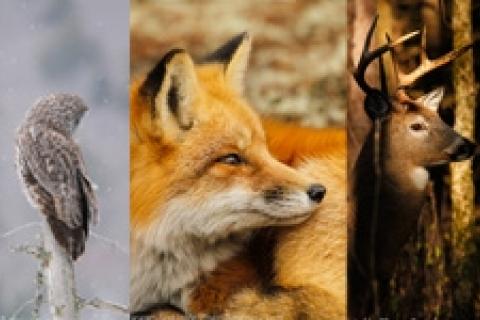
Whether you fish, hunt, camp or hike, the great outdoors is a common denominator that tie us all together. A wonderful way to capture the moments that nature offers is through wildlife photography. Most shoots can be incorporated into our existing outdoor hobbies or as a stand-alone passion. There is no specific science to wildlife photography, although there are certain practices that can help you attain a better shot.
Go Where the Animals Are
Wildlife photography can be a game of luck, but in order to up your odds, frequenting areas that are known to hold your chosen subjects is a smart move for success. Photographing deer is a passion of mine — especially during the rut. So, my ground work begins late in the summer, hiking productive-looking areas in search of buck activity, such as rubs and scrapes. Find signs of animals and you know you're in the right spot.
Check out provincial and national parks, wildlife preserves, as well as public tracts of land. Talk to park wardens, other photographers and frequent nature photography forums. These are all great avenues to point you in the right direction.
Think Like a Hunter
Although I do not hunt myself, having the mind-set and incorporating hunting practices is a smart move. Quietly stalking your subjects, using ground or tree blinds, blending in with your surroundings and learning wildlife biology and behaviors can vastly improve your shooting success.
I watch hunting shows, as well as read hunting magazines, to learn as much as I can about deer, moose, bear and geese. The same focus that hunters use to find and "shoot" their prey is similar for a wildlife photographer. The only difference is our equipment.
Camo it Up
I often joke that I have more camo clothing and gear than most of my hunter friends. It is probably true. But to blend in with your wild surroundings and remain undetected, you need to conceal yourself, especially when your photography subject is weary or skittish. This is particularly important when photography deer, coyote and turkey.
Camera Equipment Considerations
Choose a DSLR (digital single-lens reflex) camera for the best results. Incorporating a telephoto lens, such as a 200 or 300mm, should cover the bases. As you progress in this hobby, upgrading camera bodies or adding different lenses will undoubtedly occur. To start out, don't break the bank. You'll figure out what you need over time.
The majority of my wildlife photography is shot with a 150-500mm lens. This offers me both the ability to shoot close up subjects as well as those far away.
Pick the Perfect Light
Early morning and late evening are the best times to shoot outdoors. The light is often diffused and less harsh, offering up better colors and less shadows. Concentrate on these peak times. Luckily, the majority of animals are most active during these favorable periods.
![]() Read 8 Tips to Photograph the Vivid Colors of Fall
Read 8 Tips to Photograph the Vivid Colors of Fall
Have Fun Spending Time in the Outdoors
Wildlife photography is much more than capturing images, it is about witnessing behavior not often seen by most. It is about spending time in the outdoors — just yourself and nature. The most important lesson I learned early on is to "shoot a ton of images." With the advent of digital cameras, it costs nothing to fire off hundreds or even thousands of shots. Keep shooting. One of those may just end up being the perfect shot.
| Whitetail Deer | Great Gray Owl | Red Fox |
 |
 |
 |
| This image was taken during the fall rut on a public tract of land. I incorporated the early morning sun into the shot, waiting for the perfect moment for the deer to step into "the light". (Ottawa, Ontario - Canada) | I learned that a number of Great Gray Owls were frequenting Algonquin Provincial Park (Ontario, Canada) this winter. I stayed for two days and was fortunate to find two of these magnificent birds. This is one of over 3,000 images I took. | This shoot took place in Algonquin Provincial Park (Ontario, Canada.) I found two red fox while driving a back road this past fall. This one offered me a perfect profile image. |
- 4286 views

